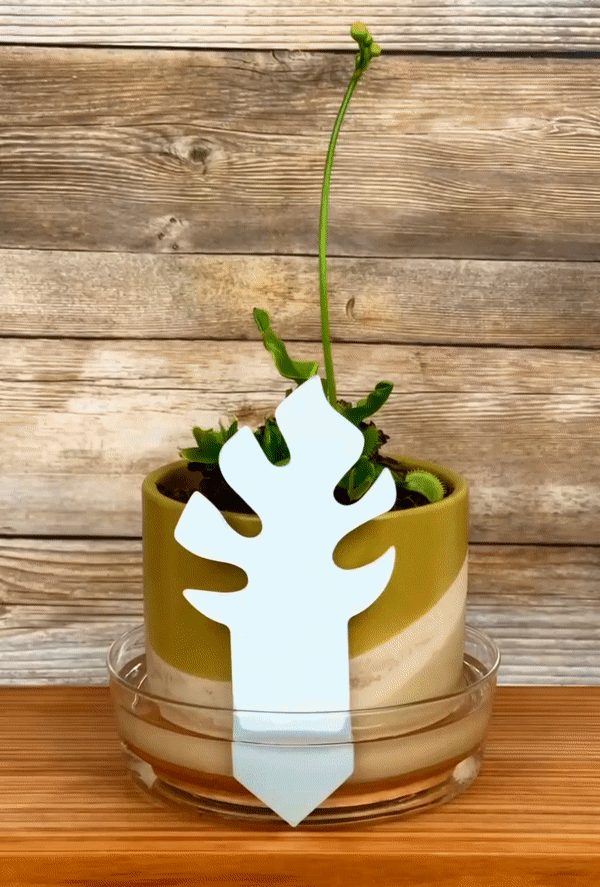A moisture meter for indoor plants (aka a plant moisture meter, moisture guide, or soil hygrometer) measures how much water a plant has access to in the soil.
Many plant owners use a “finger test” to check if their plant needs water, but this method doesn’t tell you accurately what’s going on below the surface of the soil. A plant watering indicator or moisture meter is inserted a few inches deep into the soil, and thereby and gets to the “root” of the problem.

What does a water meter for indoor plants do?
Just like people and pets, plants need water! Properly hydrating your plants is one of the most important and easiest ways to keep them healthy.
But, believe it or not, plant watering is also one of the most misunderstood parts of plant care. A water meter for indoor plants tracks the soil moisture and assists you in your regular watering routine to know and track your soil moisture level.
A plant moisture meter guides you to water…
A visible, accurate, and easy-to-read water meter helps you spot how often to water. Water is essential for plants, as plants need water to carry nutrients and perform photosynthesis. In hot weather, water can evaporate off of leaves to keep the plant cool, similar to how sweat works in mammals. Water also helps plants retain their shape and structure, as plants are up to 95% water. Without water, a plant is unable to transport its nutrients, make energy, and support itself.
… But not too much!
Too much water, however, can be a problem! While pets and people are happy with constant access to water, the majority of houseplants are a bit fussier. Overwatering often occurs when plant owners aren’t sure if their plant is ready for more water, so they err on the side of watering.

After all, it’s better to have a little extra water than too little, right? Nope! Plants can actually drown when watered too much, especially succulents, cacti, begonia, and umbrella trees. A lot of plants will die if they are watered too often 😔
Root rot also forms in wet soil that’s not allowed to drain. It’s hard to spot because most of the early damage begins below the surface. Plants with root rot often wilt even though the soil is still wet, and plant owners might mistakenly water them even more and make the root rot problem worse.
With a moisture meter for indoor plants, you can see if your plant needs water or if something else is going on below the surface!
One moisture guide we like to use is PlantDoc. Because PlantDoc is made from plant-based material, it mirrors what your houseplant is experiencing. When you water the soil, PlantDoc absorbs moisture and changes from white to green.
As the soil dries, PlantDoc dries up too, turning back to white from top to bottom. This tells you your plant's soil is dry and ready for another drink!
How to choose the best plant moisture meter for you
With so many moisture meters on the market, how can you pick the right one for you and your plants? We had the same problem at Daphne's Botanicals, so we developed our own unique solution: PlantDoc.
Unlike other moisture indicators, PlantDoc is paper-based, easy to read, and trustworthy! It’s a great tool to help you take care of your houseplants AND the earth.
PlantDoc - An intuitive tool for watering plants
Here are the details that set PlantDoc apart from other moisture meters.
Biodegradable and sustainable
After PlantDoc’s usable life (3-6 months), you can let it biodegrade in your compost, or just leave it in your house plant. PlantDoc is the only water meter for plants that is made of biodegradable and sustainable materials.
While a few other brands (such as Sustee®) use a biodegradable measuring core in their water meter products, they are encased in plastic, and not all are refillable. PlantDoc is paper-based, no harmful dyes or chemicals, and is safe for pets if Mr. Mittens decides to take a nibble. The inks used in PlantDoc are actually the same ink used on children's bath books.
Good for the earth & your budget
We want to be transparent that PlantDoc won’t last forever—and that that’s a good thing!
Compared to other moisture meters, there’s no question with PlantDoc of “what will happen to this product in a landfill?” because get to see PlantDoc biodegrade into the soil right before your eyes. And PlantDoc’s paper box is also biodegradable or recyclable. Because PlantDoc biodegrades, we keep a few extra around our house to easily refill them every three to six months.
How does the price tag and environmental cost of PlantDoc compare to other moisture meter and moisture guide options out there? We scoped around on Amazon and we saw that more “permanent” plastic moisture meters that look like a bargain—retailing for $20 or less—often had negative reviews saying the product stopped working after two to three months. So clearly, PlantDoc wins here for cost, reliability, AND environmental footprint. Both products will stop working, but PlantDoc is refillable and won’t add more waste to the earth.
Sustee is a slightly better option than cheap moisture meters, because it’s biodegradable core is refillable. However, from our experience it’s harder to read than PlantDoc, and it doesn’t solve the plastic problem.
For higher quality moisture meters that last for five years or longer, the environmental and price factors begin to even out with PlantDoc’s. Then, it comes down to personal preference and intended use. For example, our shop uses both! We use PlantDocs in medium-sized plant pots, especially if they’re in areas that are harder to reach and measure all the time. And, we use a quality moisture meter to test larger or smaller pots, and to test plants that we think will be repotted soon (since moving the soil around can disrupt PlantDoc).

Easy to read
Reading the PlantDoc moisture level is easy! As long as you can see green, your plant soil has moisture. From across the room, you can easily spot that your plant has what it needs. When I tested out other kinds of moisture meters, they weren’t as user-friendly.
Some plant moisture meters (like, Hypergrow™) use light indicators, but the colors are difficult to see in daylight. You also need to press a small button on the side to see the light, and depending on your dexterity or the density of your plant foliage, this might be cumbersome.
Sustee's color-change design is similar to PlantDoc's, but is a little harder to read because the entire color of Sustee fades as the soil dries out. So you'll have to ask yourself--is the blue a bluer blue than yesterday? Is there a hint of blue? Whereas with PlantDoc, the color change level is much more obvious because sections of PlantDoc change color (see image).
Trustworthy Measurement
PlantDoc’s patent-pending design visualizes your houseplant soil's water level in real time, exactly as your plant is experiencing it. The moisture in the soil directly changes PlantDoc’s color, so you’ll always know it’s accurate! You'll be amazed at how the color changing effect tells you so much about your houseplant soil's health and moisture.
On the other hand, other moisture meters measure electrical currents in the soil to determine moisture level. Over time, however, the measuring instruments in traditional plastic or metal moisture meters may break down or corrode. This will lead to an inaccurate reading and your plants won’t get the water levels they need.
More than just a plant moisture meter
Because PlantDoc is biodegradable, you'll even be able to catch (healthy) decomposers like mold, mushrooms or even snails that you might not otherwise see until you un-pot your plant! With this biodegradable moisture meter, you get to dive deep into your plant's soil and learn what makes them grow best.
For more information on PlantDoc:
Contact Us - for anything else!

Share:
4 Benefits of Indoor Plants for College Students